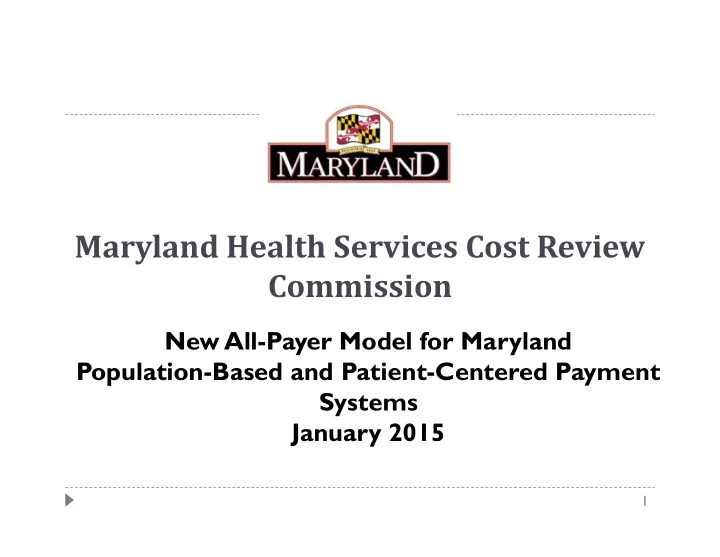

Maryland Health Services Cost Review Commission New All-Payer Model for Maryland Population-Based and Patient-Centered Payment Systems January 2015 1
Outline of Presentation Introductions Overview of New Maryland All-Payer Model and Global Budgets Opportunities for Success Public Engagement 2
Overview of New All-Payer Model and Global Budgets 3
Approved New All-Payer Model Maryland is implementing a new All-Payer Model for hospital payment Updated application submitted to Center for Medicare and Medicaid Innovation in October 2013 Approved effective January 1, 2014 Focus on new approaches to rate regulation Moves Maryland From Medicare , inpatient, per admission test To an all payer , total hospital payment per capita test Shifts focus to population health and delivery system redesign 4
New All-Payer Model for Maryland Focus shifts to the patient and improvement of care Align payment with new ways of Better care organizing and providing care Contain growth in total cost of Better health hospital care in line with requirements Lower cost Evolve value payments around efficiency, health and outcomes 5
Approved Model Timeline Phase 1 - 5 Year Hospital Model Maryland all-payer hospital model Developing in alignment with the broader health care system Phase 2 – Total Cost of Care Model Phase 1 efforts will come together in a Phase 2 proposal To be submitted in Phase 1, End of Year 3 Implementation beyond Year 5 will further advance the three-part aim 6
Approved Model at a Glance All-Payer total hospital per capita revenue growth ceiling for Maryland residents tied to long term state economic growth (GSP) per capita 3.58% annual growth rate Medicare payment savings for Maryland beneficiaries compared to dynamic national trend. Minimum of $330 million in savings Patient and population centered-measures and targets to promote population health improvement Medicare readmission reductions to national average 30% reduction in preventable conditions under Maryland’s Hospital Acquired Condition program (MHAC) over a 5 year period Quality revenue at risk to equal or exceed national Medicare programs 7
Focus Shifts from Rates to Revenues New Model Old Model Population and Value Driven Volume Driven Units/Cases Revenue Base Year Rate Per Updates for Trend, Unit or Case Population, Value Allowed Hospital Revenue Revenue Target Year Unknown at the beginning of Known at the beginning of year. year. More units/more revenue More units does not create more revenue 8
Global Budget Agreement Consumer Friendly Provisions Quality monitoring and payment provisions Adjustments for potentially avoidable utilization Efficiency adjustments Quality adjustments Corridors to examine volume changes Market share adjustment 9
Challenge for Integration of Efforts Enrollment Medical Homes Expansion Health Enterprise Accountable Care Zones (HEZ) - Medicaid Organizations -Private State Health Improvement Health Information Exchange--CRISP Process-Public Health 10
Opportunities for Success Under the New All-Payer Model 11
Opportunities for Success Improved care Improved care Global revenue budgets providing stable Global revenue budgets providing stable • • • • Delivery System Objectives and value for and value for model for transition and reinvestment model for transition and reinvestment patients patients Model Opportunities • • Lower use—reduce avoidable utilization with Lower use—reduce avoidable utilization with Sustainable Sustainable • • effective care management and quality effective care management and quality delivery system delivery system improvement improvement for efficient and for efficient and effective effective • • Focus on reducing Medicare cost Focus on reducing Medicare cost hospitals hospitals Alignment with Alignment with • • Integrate population health approaches Integrate population health approaches • • physician physician delivery and delivery and • • Control total cost of care Control total cost of care payment model payment model changes changes • • Rethink the business model/capacity and Rethink the business model/capacity and innovate innovate • • Align with physicians and other providers Align with physicians and other providers 12
Reduce Avoidable Utilization By Improving Care Examples: 30- Day Readmissions/Rehospitalizations Preventable Admissions (based on AHRQ Prevention Quality Indicators) Nursing home residents—Reduce conditions leading to admissions and readmissions Maryland Hospital Acquired Conditions (potentially preventable complications) Improved care coordination: particular focus on high needs/frequent users, involvement of social services 13
Public Engagement 14
Focus Shifts to Patients Unprecedented effort to improve health, improve outcomes, and control costs for patients Gain control of the revenue budget and focus on providing the right services and reducing utilization that can be avoided with better care • Enhance Patient Experience Maryland’s All • Better Population Health Payer Model • Lower Total Cost of Care 15
Implications for Consumers Successful hospital under a modernized waiver High quality, efficient and effective care while strategically maintaining market share Partners with physicians and other practitioners, urgent care and post acute care to improve population health Improves care resulting in reducing avoidable utilization freeing up funds for investments in population health and new technology and clinical services High quality with reduced clinical utilization will be the most successful 16
HSCRC Public Engagement Short Term Process Phases Global Budget Implementation: Fall 2013: Advisory Council - recommendations on broad principles January 2014- July 2014: Workgroups Four workgroups convened Focused set of tasks needed for initial policy making of Commission Majority of recommendations needed by July 2014 Population Focus: July 2014 – July 2015 17
Discussion-- Initial Staff Thoughts on Possible Approaches for Next Phase of Work HSCRC Multi Agency and Stakeholder Groups Advisory Council Consumer Care Coordination Engagement/ Alignment Initiatives and Models Outreach and Infrastructure Education Performance Improvement Payment Models and Measurement Potential Ad Hoc Subgroups GBR Rev/Budget GBR Infra. Transfers GBR Template Market Share. Corridor Investment Rpt. Physician Efficiency Monitoring Total Cost of Care LTC/Post Acute. Alignment 18
Recommend
More recommend